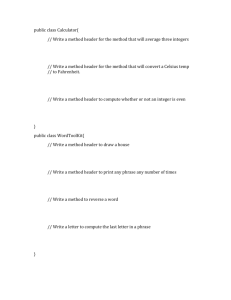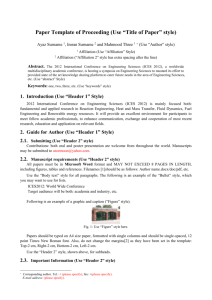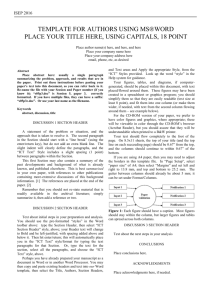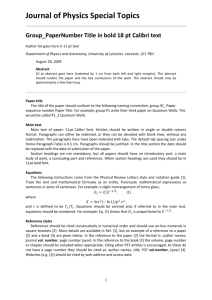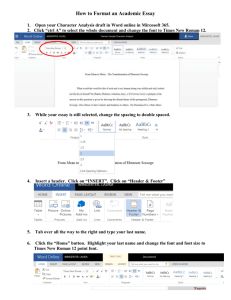10.x.x.x Bandwidth request header
advertisement
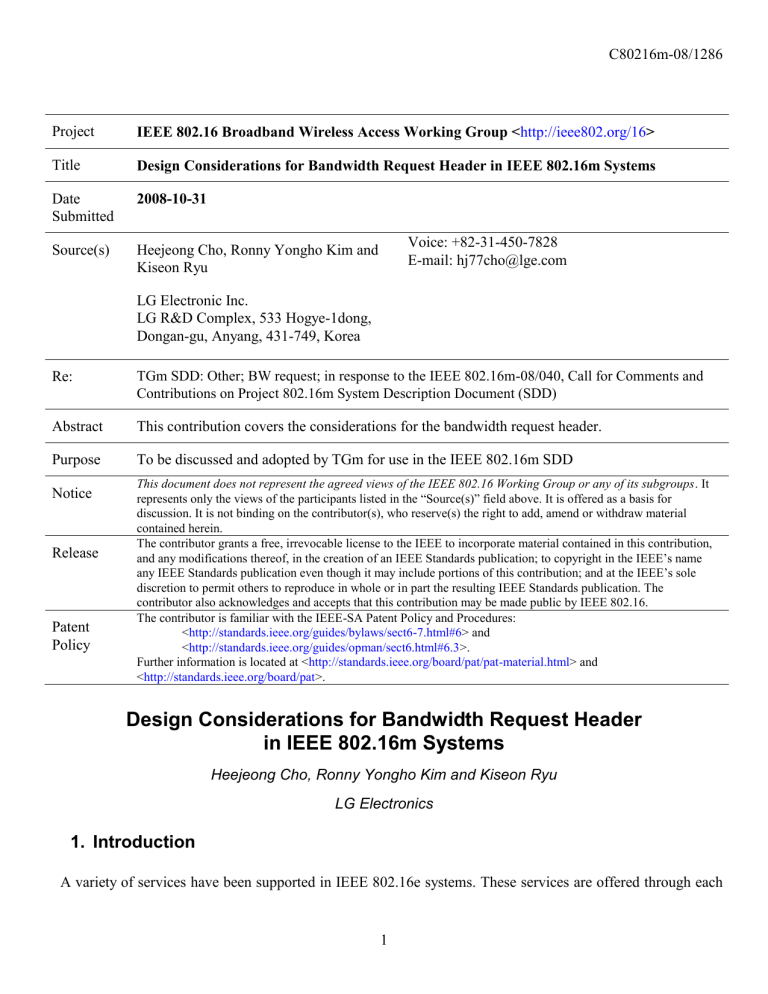
C80216m-08/1286 Project IEEE 802.16 Broadband Wireless Access Working Group <http://ieee802.org/16> Title Design Considerations for Bandwidth Request Header in IEEE 802.16m Systems Date Submitted 2008-10-31 Source(s) Heejeong Cho, Ronny Yongho Kim and Kiseon Ryu Voice: +82-31-450-7828 E-mail: hj77cho@lge.com LG Electronic Inc. LG R&D Complex, 533 Hogye-1dong, Dongan-gu, Anyang, 431-749, Korea Re: TGm SDD: Other; BW request; in response to the IEEE 802.16m-08/040, Call for Comments and Contributions on Project 802.16m System Description Document (SDD) Abstract This contribution covers the considerations for the bandwidth request header. Purpose To be discussed and adopted by TGm for use in the IEEE 802.16m SDD Notice Release Patent Policy This document does not represent the agreed views of the IEEE 802.16 Working Group or any of its subgroups. It represents only the views of the participants listed in the “Source(s)” field above. It is offered as a basis for discussion. It is not binding on the contributor(s), who reserve(s) the right to add, amend or withdraw material contained herein. The contributor grants a free, irrevocable license to the IEEE to incorporate material contained in this contribution, and any modifications thereof, in the creation of an IEEE Standards publication; to copyright in the IEEE’s name any IEEE Standards publication even though it may include portions of this contribution; and at the IEEE’s sole discretion to permit others to reproduce in whole or in part the resulting IEEE Standards publication. The contributor also acknowledges and accepts that this contribution may be made public by IEEE 802.16. The contributor is familiar with the IEEE-SA Patent Policy and Procedures: <http://standards.ieee.org/guides/bylaws/sect6-7.html#6> and <http://standards.ieee.org/guides/opman/sect6.html#6.3>. Further information is located at <http://standards.ieee.org/board/pat/pat-material.html> and <http://standards.ieee.org/board/pat>. Design Considerations for Bandwidth Request Header in IEEE 802.16m Systems Heejeong Cho, Ronny Yongho Kim and Kiseon Ryu LG Electronics 1. Introduction A variety of services have been supported in IEEE 802.16e systems. These services are offered through each 1 C80216m-08/1286 connection, established according to their characteristics (e.g., uplink grant scheduling type, maximum sustained traffic rate, maximum latency and request/transmission policy). If a MS has multiple data to be transmitted through more than two connections, the MS will follow the bandwidth request procedure for each of the connection through which the relevant data is to be transmitted. In other words, the MS should perform the procedure as many times as the number of connections through which each data is to be transmitted. That’s because bandwidth request in legacy systems is done on a connection unit basis. As in this case, requesting a bandwidth for every connection could be inefficient. Hence, it is necessary to support a variety of unit types (e.g., QoS unit or MS unit, not restricting to connection unit only) along with the corresponding bandwidth request types in IEEE 802.16m systems. We propose some design considerations for bandwidth request header in accordance with bandwidth request types. 2. Design Considerations for Bandwidth Request Header The signaling header consists of a header type, a signaling type, a header content and a header check sequence, as illustrated in Fig. 1. The header type indicates whether this header is the generic MAC header with data payload or the signaling header without data payload. The signaling type represents the kind (e.g., bandwidth request, PHY channel report, SN report or something) of the header content included in this signaling header. Therefore, the header content contains different fields according to the signaling type. Header Type Signaling Type Header Content Header Content Header Content Header Check Sequence Figure 1: An example of structure of the signaling header In this contribution, we discuss some fields to be included in the header content only when the signaling type is bandwidth request. The header content for the bandwidth request consists of a common part and an additional part, as shown in Fig. 2 and Fig. 3. The common part contains fields constantly included in the header content regardless of the bandwidth request type for supporting a variety of unit types. BR type, station identifier (only if contention based BR) and BR size are an example of the fields in the common part. The length of the BR size can be different depending on BR type. The additional part contains fields that may be optionally included in the header content according to the BR type. The scheduling type, incremental/aggregate and priority are an example of the fields in the additional part. The scheduling type indicates the reason for requesting the bandwidth (e.g., for transmitting MAC message, data of rtPS, data of nrtPS or something). 2 C80216m-08/1286 BR Type (QoS unit) BR Type Station Identifier Station Identifier (MS unit) Scheduling Type BR Size BR Size Common Part Incremental / Aggregate Priority Priority Additional Part Figure 2: An example of the header content for the contention based bandwidth request BR Type (QoS unit) BR Type (MS unit) Common Part Scheduling Type BR Size BR Size Incremental / Aggregate Priority Priority Additional Part Figure 3: An example of the header content for the non-contention based bandwidth request 3 C80216m-08/1286 Since the total length of header content could be different depending on each BR type, an MS may explicitly or implicitly notify the BS about the type of bandwidth request header that is to be transmitted. For example, the BS could know the BR type by receiving one of the BR codes related to that particular BR type, as shown in Fig. 4. MS BS Bandwidth Request Indicator (2nd code) UL grant for BW-REQ message (Resource size for transmitting BR header of type 1) BR type Code range Type 1 0 ~ 29 Type 2 30 ~ 59 BW-REQ message (BR type [QoS unit], Station identifier, BR size [size for flow A and B], Scheduling type [rtPS], …) . . . Flow ID Bandwidth Request Indicator (48th code) UL grant for BW-REQ message Scheduling type A rtPS B rtPS C BE D nrtPS (Resource size for transmitting BR header of type 2) BW-REQ message (BR type [MS unit], Station identifier, BR size [size for flow C and D], Priority) Figure 4: An example of the BR operation 4 C80216m-08/1286 References Text Proposal for the 802.16m SDD ============================== Start of Proposed Text ================================= 10.x.x MAC signaling header The signaling header consists of a header type, a signaling type, a header content and a header check sequence, as illustrated in Fig. 10.x. The header type indicates whether this header is the generic MAC header with data payload or the signaling header without data payload. The signaling type represents the kind (e.g., bandwidth request, PHY channel report, SN report or something) of the header content included in this signaling header. Header Type Signaling Type Header Content Header Content Header Content Header Check Sequence Figure 10.x : Structure of the signaling header 10.x.x.x Bandwidth request header The header content in the MAC signaling header for the bandwidth request consists of a common part and an additional part, as shown in Fig. 10.y and Fig. 10.z. The common part contains fields constantly included in the header content regardless of the bandwidth request type for supporting a variety of unit types. BR type, station identifier (only if contention based BR) and BR size are an example of the fields in the common part. The length of the BR size is different depending on BR type. The additional part contains fields that may be optionally included in the header content according to the BR type. The scheduling type, incremental/aggregate and priority are an example of the fields in the additional part. The scheduling type indicates the reason for requesting the bandwidth (e.g., for transmitting MAC message, data of rtPS, data of nrtPS or something). 5 C80216m-08/1286 BR Type (QoS unit) BR Type Station Identifier Station Identifier (MS unit) Scheduling Type BR Size BR Size Common Part Incremental / Aggregate Priority Priority Additional Part Figure 10.y : An example of the header content for the contention based bandwidth request BR Type (QoS unit) BR Type (MS unit) Common Part Scheduling Type BR Size BR Size Incremental / Aggregate Priority Priority Additional Part Figure 10.z : An example of the header content for the non-contention based bandwidth request ============================== End of Proposed Text ================================= 6

